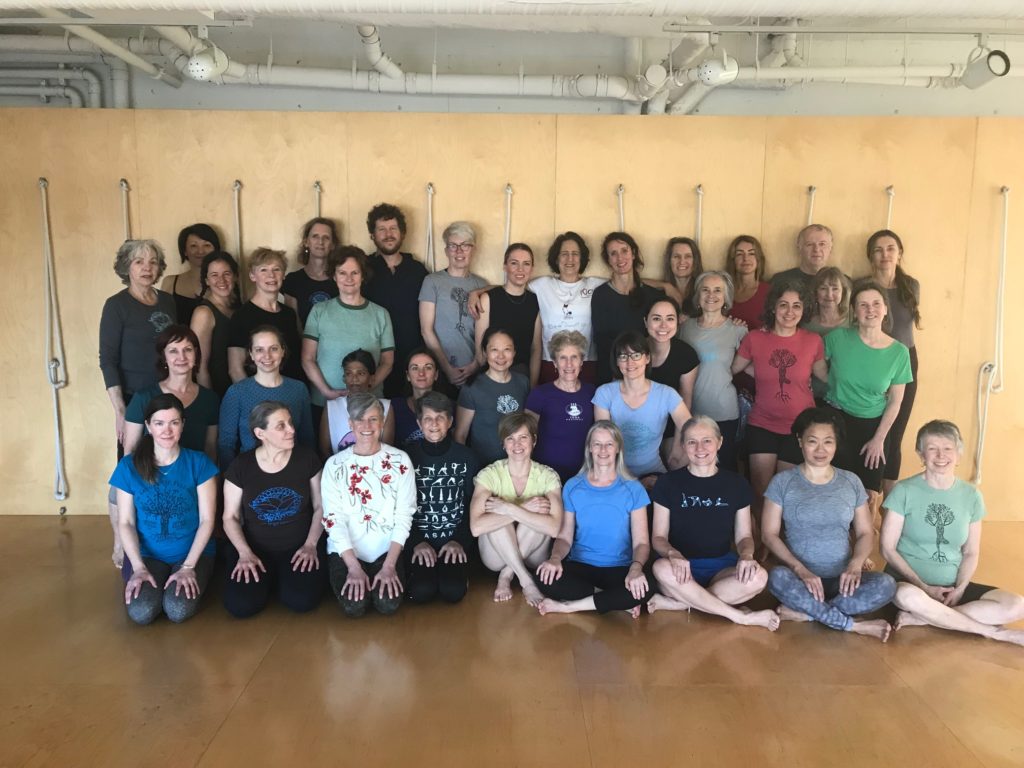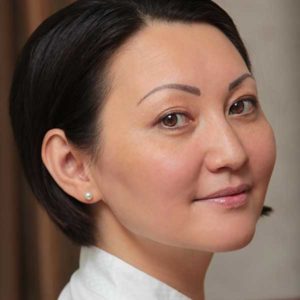Interview with Gabriella Giubilaro
by Bibigul Amirova
The B.K.S. Iyengar Yoga Association (Vancouver) had the pleasure of welcoming Gabriella Giubilaro for a 3 day workshop followed by a half day teacher training intensive. On the final day, Gabriella was kind enough to provide answers to questions compiled by Bibigul Amirova. The following is a transcript (provided by Christine Rondeau) of that interview and it’s been edited briefly for clarity.

How would you describe the benefits of a daily yoga asana practice and what does it bring to someone’s life?
The daily practice is the sadhana. As it is your sadhana, you can choose what to do. You can do asana or pranayama and asana. In the beginning most people only do asana. It’s your surrender, your dedication, your sadhana. It brings stability in your life and strength. It’s not a question of becoming more supple or stronger. It’s tapas. It is the part of the tapas that we do and brings results. For me it’s strength, solidity and of course, passion.
Of course sometimes, even for myself, it’s hard to find time for the practice because of family, children, work, travel and many things… Find the time, no matter what, to have your discipline, to go inside and do your daily practice.
Maybe it takes time, takes a lot of time, but you see the results and it’s independent from how you practice. It’s independent of whether you do advance poses, easy poses, introductory poses, senior poses… it’s totally independent. The sadhana, the practice, the tapas is the only thing we have. We mature and we grow from there. If the practice is not daily, it’s not consistent… for a long time… Read the definition of abhyasa and study what Patañjali says about practicing for a long time in a steady consistent way and once you’ve done this for years, you cannot miss it. Again it’s not important that you do advanced asanas. Any practice that you do every day has a result.
Guruji is an example of someone who put his practice as the first thing in his life. Even when he had six children and he was married, still his practice was number one. It’s from his personal practice that he understood, discovered and learned how to see our bodies. It’s from watching and observing our own that we see others.
I’ve never met BKS Iyengar personally and have only seen him in videos. He sometimes comes across as very strict and serious. Was that your experience and in your opinion is there a need to be strict when teaching Iyengar yoga?
This is a confusion many people have. Personally, I have the reputation of being a hard teacher. That’s because people confuse being strict and serious with being hard. If you have a child and everything that the child does and wants, you agree with… ? Sometimes you have to be strict. If you are strict, you educate. Guruji was strict, yes! He was serious. He was intense, but his intensity was meant to wake us up. Unfortunately in our society, this is considered a bad thing.
The teacher that is “hard”, the one that teaches you the tapas; it is that teacher who transforms you. It’s only from there that you get transformation.
I can see it now with the granddaughter, Abhijata; the energy, the life that she has and I’m sure that the grandfather, Guruji, was very tough with her. The stories that she sometimes tells.. I’m very happy I was not there and that he didn’t do that to me. He was tough, but he wanted transformation and that’s the lineage in India.
The guru. What does it mean, guru? Guru means weight. When you study grammar, there are rules for light and heavy. In Sanskrit these words are laghu and guru. The tradition is that the guru in India is heavy. He’s a heavy person. I know that in our kind of society or education, we don’t like this concept. Many people left Iyengar because of that. The problem is the people that copy him. I’ve seen this from the beginning. Teachers going around shouting, screaming, beating people, without knowing what they are doing. That’s the problem, because he knew exactly where to touch, who to scream at, but he could also be very nice, very kind, very gentle with some people and very tough with others. He knew what he was doing.
Outside the class he was sweet and gentle. He was very interested and asked many questions and wanted to know about you and your life. He was a totally different person. It helped me a lot because the first time I went to India, like a lot of people, I was terrified. I was scared every time he came close to me. The first task I gave myself was not to close my eyes when he was coming near me. Can you imagine? I was always hiding behind a column and no matter what he was always finding me. I was always hiding somewhere, but outside the class, he was never tough. That wasn’t his point. His point was to shake us, to awake us, to find something… that was the change.
I understand that it’s not part of our culture. In our culture, if you have fear or pain, you don’t learn. This is our tradition. You learn if you have no fear and no pain. And I agree with that part, but that’s not the Indian tradition. In the Indian tradition, the guru is Guru and you never question him, but you have to take him in that context. Sometimes it’s hard to balance our tradition with their tradition and a lot of problems and disasters happened in Iyengar Yoga and other systems when these (traditions) meet with the East. Some misunderstandings take place when some traditions are ok in India are are not ok here and vice versa. Read the book “After the ecstasy, the laundry” by Jack Kornfield. It’s one of the best books I’ve read and it helped me a lot. It’s about the problems between east and west. Some things that are ok in the west, are not ok here and then what the people in the east did and misbehaved in the west, because of weakness, because of power… but it’s not only the Indian people, it’s very common with teachers and people in high positions.
Guruji, was very tough and strong, but I had the impression that he couldn’t help it. It was part of his personality. He had so much fire, he couldn’t help it. That’s who he was and this was also the beautiful part. It was beautiful to see him in his asanas, in his teaching. Some didn’t like this and they went away. He used to say, “I’ve lost so many people, if I lose one more it’s ok, I don’t care“.
When I say to someone who doesn’t know much about yoga, that I teach in the Iyengar tradition, they ask me, how it is different from other yoga traditions. How would you answer this question?
I don’t like it when people say that “Iyengar yoga is alignment”. Iyengar Yoga is not alignment because (physical) alignment is only a small part. It’s the minimum, you need to do yoga. It’s not the end of our yoga practice. You don’t do a good asana because you are aligned. But if you are not aligned, you cannot open the parts that are closed, you cannot strengthened the parts that are weak and the energy cannot flow. So what’s important and what Guruji taught us is not the alignment, it’s the life in the asana, it’s the extension of every part of the body in the asana and you cannot do it if you are not aligned.
I don’t want to point the finger at any other types of yoga, but in every asana, even the most simple one, you have to open, you have to extend, you have to expand. There must be life everywhere in the body and this is what we have to see when we teach… where the body is dead.
Guruji told me once… we were doing back bends. We were doing urdhva dhanurasana and he was walking by. As he walked passed me, he slapped my arm and said “Full of life”, then slapped my legs and said “Completely dead” and walked away. And he was right. My buttocks were down, my pelvis was down… I had to struggle for years and still do, to make my legs work and have the same life quality as my upper body. I never had problems opening up or lifting parts of my chest or arms, but my pelvis and legs were always heavy.
Some others have life in their legs and are dead in their upper body. It’s nothing bad and no one is perfect. There’s no one that is full of life everywhere. That’s an illusion. Very few people are stiff everywhere and they are the lucky ones. Most of us have weak parts and stiff parts, so our job, and this is where alignment comes in, is to learn how to open where we are stiff and how to resist where we are weak. I had to close my chest and learn how not to overwork the chest in order to work on the pelvis and the legs. I struggled and did urdhva dhanurasana with a chair, with different tools, resisting my chest with a brick at the wall and tried many things to learn how to work the pelvis and the legs. If you watch Mr. Iyengar doing urdhva dhanurasana and kapotasana with a chair, you can see that he has a lot of support. He always had support, particularly later in life. He wasn’t doing the poses from the floor. So, he was using his creativity to learn.
If you have this tapas, this fire and interest in learning, you also have the creativity. The creativity awakens your intelligence. If you just try to copy over and over again, it does not lead to intelligence.
There is a story that Abhijata recounts. One day, Guruji was working with her on marichyasana III. The next day, she decided to go early in the morning to practice before he got there, so she could work without him telling her what to do. So she was there and repeating yesterday’s practice. And then Guruji walked in and said “What are you doing?” And she said, “I’m doing what we did yesterday”. To which he said, “Yesterday is yesterday, it’s gone. Don’t do the same thing today, today is today and you need to do today”.
Of course we need to repeat and repeat. In the beginning you need to listen to the teacher and repeat what the teacher says and does, but then you have to explore. Even if you do something wrong. I did this a little bit with you during the workshop. I said things, like “Go a little towards the right off your sitting bone, then back on your sitting bone”… If you never explore, you never understand. Our yoga should not be mechanical.
We as teachers should never repeat the same class, the same instructions, the same thing. Always be fresh, always be new. This doesn’t mean creating new asanas. Teach from a different point of view. Maybe you change sequence, timing, things that you say. Shock your students. Say something that they don’t expect. That’s the only time the person wakes up.
Our brain has to save energy because the brain is the organ that uses the most energy. Because the brain uses too much energy, when we repeat, the mind doesn’t pay attention anymore and you move mechanically. This shouldn’t happen in yoga. We should always be fresh, new and observant. When we are mechanical, we’re not doing yoga anymore. When we’re driving, it’s ok to be mechanical, but not while doing yoga.
While doing yoga, you have to be aware. “I will lift the arm”, I lift the arm. “Now I will take the arm down”, then you take the arm down. “I will do this”, I do this, etc… You always need to be aware before any movement, you have to decide to make that movement, and then you move. Then you learn a little bit about yoga. You learn how to train the attention. Don’t forget the asanas are an excuse to educate the mind. Yoga citta vritti nirodha… no?
Yoga is learning how to see the mind, how to control it and how to make it use its senses of perception at some times and not at other times.
The yamas and niyamas are the first part that helps us save energy. Everything is about energy. We cannot do meditation because we don’t have enough energy to sit quietly for long periods of time. We get distracted, so we need some training. So first of all you have the yamas and the niyamas, then the asanas. It’s during the asanas that you train your attention in the body from the beginning to the end. From the beginning of the asana, to the end of the asana and from the beginning of the practice, to the end of the practice. If it’s done mechanically, then it’s not yoga anymore.
Then there’s pranayama and pratyahara. Pratyahara is the link between the external and internal work. Try to do this from the beginning. We cannot wait until we are eighty or ninety and say “now I start this”. The limbs* of yoga can be seen like the branches of a tree. They all help each other. So start a little bit to work on the other limbs of yoga.
So pranayama and pratyahara are the limbs that look from the external to the internal. Next comes dharana which is attention, dhyana which is meditation and samadhi, which is a gift of God. We can forget about samadhi though… who wants samadhi?
To summarize, if someone were to ask you “What is Iyengar Yoga, is it alignment?” You need to say, “No, it’s attention, attention in the body”. Of course then you tell them about the benefits of the Iyengar practice, to our bodies, our health and organs.
There’s also criticism of the props we use. If someone asks you about this, you can tell them that we use props to become more aware and to awaken different parts of the body that need more help than others.
You travel and teach all over the world. Do you see any differences between Vancouver and Canadian’s practice compared to the rest of the world?
I can only tell you about the Italians and the Russians. The Italians love to talk during class and share recipes. They are never too serious and they dismiss certain things as not important. If I mention part way during a class that were now doing pranayama, all of a sudden someone will stand up and say they need to leave and go to the movies. If I keep them in paschimottanasana for 10 minutes, after 3 minutes, someone will start sharing their latest eggplant recipe. These are the Italians.
In Russia, everything you say, they do too much and I have to tell them, “Enough, enough”. They are so disciplined for their education. Most of the time they’ve worked so hard that they need to understand how to relax and how to do less. I used to go to Rome to teach and then people wouldn’t show up, because it was sunny and they went to the beach instead. Now if I go to Rome, I go in the winter.
The difference is personality. Of course there are differences, but overall here in Canada it seems to be an average.
Personally I don’t like it when a person dresses too nicely for yoga or comes too nicely made up. We are meant to watch inside, that’s what’s important. A lot of teachers laugh at my bloomers. You have no idea what some of my bloomers look like. Some all all baggy and stretched, but I still wear them in workshops and in my class in Florence. I don’t wear these because I want to look funny, but because I don’t want to give the example that what you are outside is the most important thing. Of course I do my best to be clean… That’s a different story.
The beauty is inside and this is what we have to find with your yoga. Our inner beauty. Guruji was also like that. Externally he was a hard person, but inside he was beautiful. So don’t judge people from the outside.
*The limbs of yoga, refer to the eight components of yoga, not physical limbs as in arms and legs.

